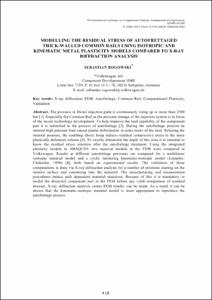Mostra el registre d'ítem simple
Modelling the residual stress of autofrettaged thick-walled common rails using isotropic and kinematic metal plasticity models compared to X-ray diffraction analysis
| dc.contributor.author | Rogowski, Sebastian |
| dc.date.accessioned | 2016-01-13T15:53:29Z |
| dc.date.available | 2016-01-13T15:53:29Z |
| dc.date.issued | 2015 |
| dc.identifier.isbn | 978-84-944244-6-5 |
| dc.identifier.uri | http://hdl.handle.net/2117/81378 |
| dc.description.abstract | The pressure in Diesel injection parts is continuously rising up to more than 2500 bar [1]. Especially the Common Rail as the pressure storage of the injection system is in focus of the recent technology development. To help improve the load capability of the component part it is submitted to the process of autofrettage [2]. During the autofrettage process an internal high pressure load causes plastic deformation in some zones of the steel. Relaxing the internal pressure, the resulting elastic hoop induces residual compressive stress in the inner plastically deformed volume [3]. To exactly dimension the depth of this zone it is essential to know the residual stress situation after the autofrettage treatment. Using the integrated plasticity models in ABAQUS® two material models in the FEM were compared at Volkswagen. Results at different autofrettage pressures are computed for a multilinear isotropic material model and a cyclic hardening kinematic-isotropic model (Lemaitre-Chaboche, 1990) [4], both based on experimental results. The validation of these computations is done via X-ray diffraction analysis for a number of positions starting on the interior surface and continuing into the material. The manufacturing and measurement procedures induce path dependent material situations. Because of this it is mandatory to model the dissected component part in the FEM before any valid comparison of residual stresses, X-ray diffraction analysis versus FEM results, can be made. As a result it can be shown that the kinematic-isotropic material model is more appropriate to reproduce the autofrettage process. |
| dc.format.extent | 11 p. |
| dc.language.iso | eng |
| dc.publisher | CIMNE |
| dc.subject | Àrees temàtiques de la UPC::Matemàtiques i estadística::Anàlisi numèrica::Mètodes en elements finits |
| dc.subject | Àrees temàtiques de la UPC::Enginyeria mecànica::Motors::Motors dièsel |
| dc.subject.lcsh | Finite element method |
| dc.subject.lcsh | Plasticity -- Mathematical models |
| dc.subject.lcsh | Plasticity |
| dc.subject.lcsh | Diesel motor |
| dc.subject.other | X-ray diffraction |
| dc.subject.other | FEM |
| dc.subject.other | Autofrettage |
| dc.subject.other | Common Rail |
| dc.subject.other | Computational Plasticity |
| dc.subject.other | Validation |
| dc.title | Modelling the residual stress of autofrettaged thick-walled common rails using isotropic and kinematic metal plasticity models compared to X-ray diffraction analysis |
| dc.type | Conference lecture |
| dc.subject.lemac | Elements finits, Mètode dels |
| dc.subject.lemac | Plasticitat -- Models matemàtics |
| dc.subject.lemac | Plasticitat |
| dc.subject.lemac | Motors dièsel |
| dc.rights.access | Open Access |
| local.citation.contributor | COMPLAS XIII |
| local.citation.pubplace | Barcelona |
| local.citation.publicationName | COMPLAS XIII : proceedings of the XIII International Conference on Computational Plasticity : fundamentals and applications |
| local.citation.startingPage | 418 |
| local.citation.endingPage | 428 |
| local.citation.edition | CIMNE |


